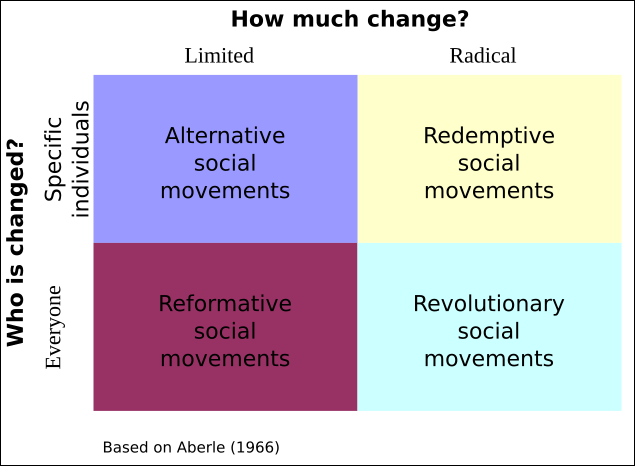3. Identify and contrast the different types of social movements

4. Discuss the tactics that social movements employ, and how and why these tactics are chosen.
Movements select from a repertoire of possibilities available to them at any given time and place. Some tactics, such as mass demonstrations against administrative practices, are rare in autocratic societies but common in democracies. Other tactics, such as hangings in effigy, were popular for centuries in England and the United States but have largely gone out of style. Some movements rely on verbal appeals, others on a combination of exhortations and demonstrations; still others add the threat and use of force. Movements have characteristically relied on confrontational tactics to advance their cause, and this is still the method of choice for street protests. But movements seeking both ideological change and resistance to ideological change are increasingly turning to cultural politics.
ConfrontationConsider once again the demonstrators at Tiananmen Square, some of them on hunger strikes, none of them knowing at what point the government would strike back. When it comes to making a statement, there is nothing quite like putting one's body on the line. Conflict theorist Thomas Schelling distinguished in this connection between speech and moves, the latter capable of "altering the game" by demonstrating a willingness to incur costs. Said Schelling, "Talk can be cheap when moves are not." (Schelling, Strategy of Conflict, Cambridge, 1960)
The moves the protestors at Tiananmen were making were forms of confrontation. They were reminiscent of the campus sit-ins and demonstrations at colleges and universities across the United States in the late sixties. Some of the campus confrontations were fairly mild while others were quite disruptive, but all of them sought to perform attention-getting, radicalizing, and delegitimizing functions through actions that combined verbal exhortations and pressure tactics.
The confronter joined in a deliberate violation of the institution's written and unwritten code of conduct, fastening on those taboos which symbolized what the protestors took to be the institution's false ideals and inequitable practices. Their aim was to embarrass the institutions into making concessions. Representatives of these institutions were thus presented with a king-sized dilemma. Suppression of the confrontation would belie the institution's appearance of liberality and feed the flames of protest. Yet permitting violations of the code would, in effect, sanction other violations and undermine the offices of authority and discipline in the institution. And so, after promising a fair hearing and pleading in vain for a return to more moderate tactics, the institution acted to check or suppress the violations and punish the violators, frequently breaking its own rules in the process. In this way, its representatives were able, temporarily, to contain the confrontation, but, in doing so, they unwittingly fulfilled their assigned roles as villains.
Cultural PoliticsConflicts between movements and counter-movements are not always played out on the streets. For example, groups seeking liberalization of social values (the "cultural left") and others resisting what they see as moral decay ("social conservatives") have in recent years been engaged in what some journalists ballyhooed as the "culture wars." Multiculturalists, Afro-centrists, feminists, and others on the cultural left have sought to influence educational curricula. Social conservatives have formed counter-movements of their own, pressing in some cases for textbook censorship, and in others for cutbacks in federal funding of the humanities. Some social conservatives have sought to restore America to what they allege was its former greatness, before school prayer was outlawed, for example, and before abortion was legalized by the Supreme Court.
These ideological battles are fought out less in the streets than in behind the scenes meetings of museum boards, federal funding agencies, university administrators, mental health professionals, network news managers, etc., and, more openly via television and in classrooms, movie theaters, churches, mental health centers, and the courts. In one Women's Studies classroom, for example, a concerted attempt is made to "liberate" students from the intellectual and cultural domination of patriarchal (i.e., male-oriented) ideologies. Across the hall, a socially conservative professor of philosophy declaims against postmodernism, deconstruction, culturalism relativism, and other intellectual challenges to Western culture's traditional faith in logic, objectivity, meaning, and scientific method. These are but skirmishes in today's cultural wars, but they illustrate within an academic setting what is meant by cultural politics. It is an attempt by all sides to influence ideological thought via institutions such as the schools that are not often thought of as vehicles for propagandizing. Its methods include not just active proselytizing but control over what gets put before students in the way of textbooks, television viewers in the way of programming, museum goers in the way of art exhibits, and so on.